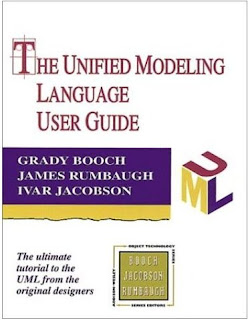E-Book Details:
Title: | The Unified Modeling Language (UML) |
Publisher: | Addison-Wesley Professional |
Author: | Grady Booch, Dr. James Rumbaugh, Dr. Jacobson |
Edition: | Hardcover, 1 edition (September 30, 1998) |
EditionNumber: | Updated 2009 |
ISBN: | 0-201-57168-4 |
EAN: | 978-0201571684 |
No. of Pages: | 512 |
Book Description:
The Unified Modeling Language (UML) is a graphical language for visualizing, specifying, constructing, and documenting the artifacts of a software-intensive system. The UML gives you a standard way to write a system's blueprints, covering conceptual things, such as business processes and system functions, as well as concrete things, such as classes written in a specific programming language, database schemas, and reusable software component. The "Unified Modeling Language User Guide" is the first of two UML works written by the creators of UML. This book will introduce the core 80% of UML, approaching it in a layered fashion and providing numerous examples of its application. The title is suitable for developers unfamiliar with UML or with modeling in general.
ABOUT THE AUTHORS:
Grady Booch, is the Chief Scientist at Rational Software Corporation and developer of the Booch Method of object-oriented analysis and design. He is also co-developer of the Unified Modeling Language (UML). Widely recognized for these and many contributions in the field, he is a popular speaker at technology conferences around the world. Booch has twice received Software Development magazine's coveted Jolt-Cola Product Excellence Award for his seminal text, Object-Oriented Analysis and Design with Applications.
Dr. James Rumbaugh is one of the leading object-oriented methodologists. He is the chief developer of the Object Modeling Technique (OMT) and the lead author of the best-selling book Object-Oriented Modeling and Design. Before joining Rational Software Corporation in October 1994, he worked for more than 25 years at General Electric Research and Development Center in Schenectady, New York.
Dr. Rumbaugh received his Ph.D. in computer science from MIT. During his Ph.D. research under Professor Jack Dennis, Dr. Rumbaugh was one of the inventors of data flow computer architecture. His career has dealt with semantics of computation, tools for programming productivity, and applications using complex algorithms and data structures. Dr. Rumbaugh has published journal articles on his work and has spoken at leading object-oriented conferences. He writes a regular column for the Journal of Object-Oriented Programming.
Dr. Ivar Jacobson, Vice President of Business Engineering, is the inventor of the OOSE method, and he is also the founder of Objectory AB in Sweden, which recently merged with Rational Software Corporation. Dr. Jacobson is the principal author of two influential and best-selling books Object-Oriented Software Engineering--A Use Case Driven Approach (Computer Language Productivity award winner in 1992) and The Object Advantage--Business Process Reengineering with Object Technology. He has also authored several widely referenced papers on object technology. One of the most famous papers is his first OOPSLA '87 paper entitled "Object-Oriented Development in an Industrial Environment," which presented the first truly object-oriented method ever published. Ivar Jacobson's use-case driven approachhas had a very strong impact on the entire OOAD industry, and he himself has become one of its "icons." Consequently, he isa frequently invited keynote speaker and panelist, debating OOAD topics withcolleagues and methodologists such as Grady Booch, Jim Rumbaugh, StevenMellor, and Rebecca Wirfs-Brock at major OO conferences around the world.
Table of Contents:
Organization and Special Features
Organization and Special Features
The user guide is organized into seven major sections:
· Section 1 Getting Started
· Section 2 Basic Structural Modeling
· Section 3 Advanced Structural Modeling
· Section 4 Basic Behavioral Modeling
· Section 5 Advanced Behavioral Modeling
· Section 6 Architectural Modeling
· Section 7 Wrapping Up
The user guide contains three appendices: a summary of the UML notation, a list of standard UML elements, and a summary of the Rational Unified Process. A glossary of common terms is also provided.
Each chapter addresses the use of a specific UML feature, and most are organized into the following four sections:
1. Getting Started
2. Terms and Concepts
3. Common Modeling Techniques
4. Hints and Tips
The third section introduces and then solves a set of common modeling problems. To make it easy for you to browse the guide in search of these use cases for the UML, each problem is identified by a distinct heading.
Each chapter begins with a summary of the features it covers, as in the following example.
In this chapter
· Active objects, processes, and threads
· Modeling multiple flows of control
· Modeling interprocess communication
· Building thread-safe abstractions
Similarly, parenthetical comments and general guidance are set apart as notes







 Newer Post
Newer Post
 Older Post
Older Post

1 comments :
I can't download the file because mediafire remove the file....i really needed!!! please can you uploaded again
Post a Comment